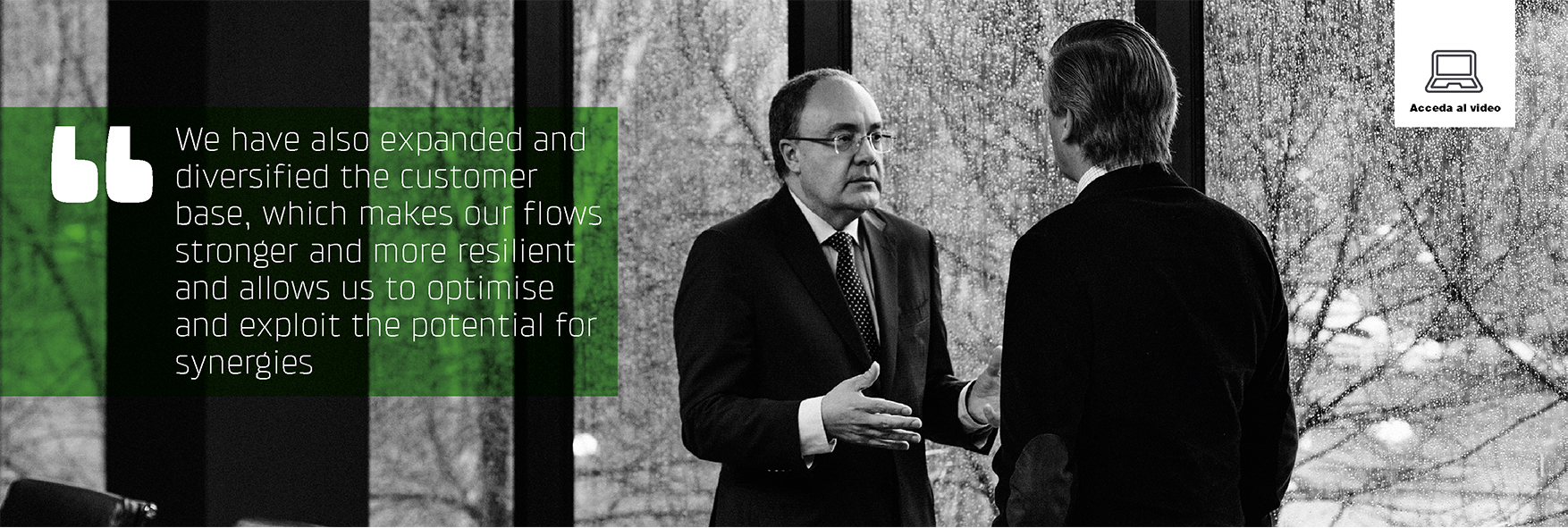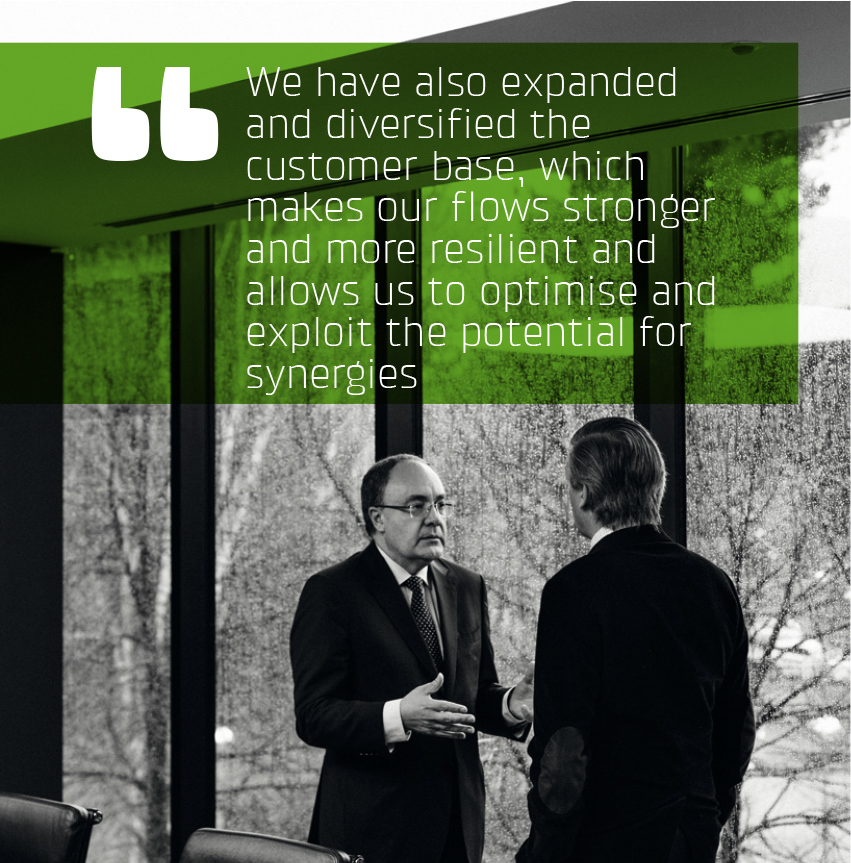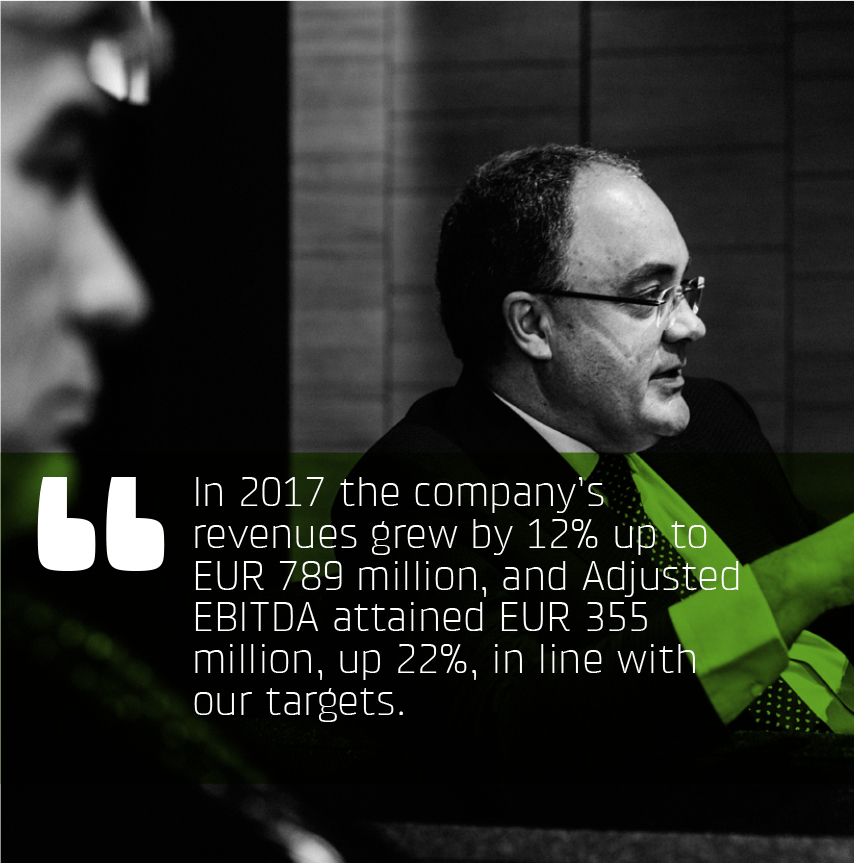1. Consolidation, Growth, Innovation


What have been the main factors affecting Cellnex’s business in 2017? What would be the main headlines of the financial year?
Francisco Reynés: I would highlight the continuity and consolidation of the process of building Cellnex's European project that over the past two and a half years - since the IPO - has enabled us to close 12 transactions in six countries with a global investment of approximately EUR 3,300 million, growing from 7,000 sites located mainly in Spain to almost 27,000 in Spain, Italy, France, the Netherlands, Switzerland and the United Kingdom on a run-rate basis. I think we should also commend the skill of the management team in finding a balance between strong and rapid growth and managing the business at constant scope. Not only are we growing, but we have also shown that we are consolidating that growth by rigorous and disciplined day-to-day management.
Tobias Martinez: I would add that a key factor has been the diversification of the company's business profile, reflecting this intense growth process that the President has referred to. For instance, telecom infrastructure services already account for 60% of the Group's revenues, while only three years ago the figure was a mere 24%. We have also diversified our revenues by geographical market; 42% of revenue already comes from outside of Spain, which rises to 52% if we annualise the effect of all our acquisitions during the year. We have also expanded and diversified the customer base, which makes our flows stronger and more resilient and allows us to optimise and exploit the potential for synergies by working alongside customers with a presence in various markets where Cellnex is also present.
In addition, the accumulated investment during 2017 amounted to EUR 1,183 million.
We asked the same question in 2016, but is there a limit to this growth?
TM: The limit does not seem to be so much in the potential for consolidation available to an infrastructure operator such as Cellnex in the European market - with almost 300,000 towers and sites - and with a clear tendency on the part of the sector's players to outsource their voice and data transmission networks; but rather in our capacity to properly manage the integration of these assets, manage them, meeting the commitments that we have acquired with our customers, and obviously designing adequate and competitive financing structures for the company.
Therefore, as we said a year ago, it is difficult to determine where the limit lies and in any case it will be the result of an intelligent combination of our own management capabilities coupled with making the most of the growth opportunities that the market in Europe continues to offer.

Cellnex is a publicly traded company. A year ago the 2016 closing share price that did not seem to have appreciated the company’s strong growth in the various markets in which it operates. Cellnex’s performance on the stock market in 2017 has been radically different, however. How would you rate the financial year on the stock exchange?
FR: It’s fair to say that Cellnex has had an excellent year; the stock has been at the top of the IBEX 35 in terms of revaluation, attaining 56% compared with the close of 2016 and 53% up on EUR 14, which was the issue price when the company was floated on the stock market in May 2015. Another aspect is the revaluation of Cellnex in relation to the IBEX 35 since its flotation and it is worth noting that, since it was selected, the company has improved by 63%, again since May 2015.
TM: Accordingly, it seems that in 2017 the market has indeed factored in to a large extent both the increase in the company’s scope - through growth in 2016 and 2017 - as well as the stability, recurrence and visibility of the flows produced by this growth; one factor confirming this is the portfolio of sales already agreed in excess of EUR 16,000 million, equivalent to practically 20 years of turnover, taking the end of 2017 as reference.
In short, what these data show is the industrial value of Cellnex, a model with a long-term vision and potential, a model that we understand is attractive to our shareholders and has earned the confidence of the analysts tracking the company, most of whom - 65% - are maintaining a recommendation to purchase, with a margin for improvement on account of the differential between the average price and the listed price.
In line with the opportunities that the market in Europe continues to offer and the confidence in the Cellnex model that both investors and their customers seem to share, what is the company's strategy to continue financing this growth?
TM: As at 31 December 2017, Cellnex has a very competitive debt structure (6 years average maturity) and average cost of debt (2.4%); in addition, combining cash flow and immediate access to unallocated borrowings, the company has access to liquidity in the vicinity of EUR 1,400 million (EUR 2,000 million in January 2018 after the issue on January 8 of the company's first convertible bond for an amount of EUR 600 million, which has taken the average cost of the debt drawn and undrawn to 1.9% and raised the average maturity to 6.4 years). We therefore have the necessary resources to continue considering growth projects that may arise in the fairly immediate future.
FR: Note that the company, as we recalled at the beginning, has committed EUR 3,300 million in growth operations over the past two and a half years and has done so on the basis of its own balance sheet without recourse to its shareholders. The company’s capacity to generate cash is very important, as it allows the flows that are incorporated through growth to contribute from the start to reducing the ratio of net debt to EBITDA. We assume that Cellnex is a company that can reduce this ratio on a run-rate basis by a multiple equivalent to 0.6x every 12 months.
TM: We therefore have a robust balance that allows us to consider growth based on our own borrowing capacity, without ruling out scenarios involving cooperation with other partners, such as the acquisition of Swiss Towers in Switzerland in 2017 or other alternatives that can be considered in terms of the company’s growth opportunities.
And regarding the business, what have been the key figures for the year in terms of income, EBITDA, etc.?
TM: In 2017 the company's revenues grew by 12% up to EUR 789 million, and Adjusted EBITDA attained EUR 355 million, up 22%, in line with our targets. The net result closed at EUR 33 million. In the case of the net result, the effect of higher depreciation and amortisation should be noted (up 27% on relation to 2016) and financial costs (up 48% on 2016) associated with the group’s dramatic growth and the consequent expansion of its scope.
I would also like to highlight the company’s good performance in terms of organic growth, or at constant perimeter, which is still in line with the 4% that we set as the target. In that connection, the customer ratio was 1.55x, while the "Points of Presence" (equipment installed in the sites) increased to 30,149, which represents a 4% growth at constant perimeter.

The governance of all companies is key, but especially listed ones like Cellnex that are also members of the selective IBEX 35. What would you highlight of this 2017 in terms of corporate governance and responsibility, transparency, diversity, etc.?
FR: There are two particularly noteworthy aspects of the corporate governance of the company: firstly, the expansion of the board from 9 to 10 members, which increased the independence of the board through the addition of a new independent director, bringing the number of independent directors to 5 out of 10, also making progress on compliance with gender diversity recommendations; an area in which we are aware of the path we have to take to comply with the recommendations on corporate governance planned for the year 2020. And a second aspect that I find remarkable from the perspective of strengthening corporate governance and the decisive role played by independent directors, is the appointment of Bertrand Boudewijn Kan, chairman of the Audit and Control Committee, as Vice-Chairman of the company.
We have also continued to deploy the various corporate governance policies, ensuring that governance policy goes hand-in-hand with the growth of the company so that it is spread in a uniform and coherent manner into all the countries and businesses that the group gradually expands into. This is an especially important factor as it forms part of the excellence in day-to-day management operations at the same level of performance and rigour that the company promises to its customers. The Board has also paid particular attention to monitoring and adapting plans for the succession of the main management positions as a key element of business continuity.
TM: In terms of governance, transparency is one of the most important principles, and in that connection I would like to stress that for the second consecutive year the Official Chamber of Commerce of Barcelona and the Institute of Financial Studies (IEF) have acknowledged in their annual study that Cellnex Telecom is among the Spanish companies with best practices, based on an assessment of the quality, reliability, frequency and scope of the information that the company provides to the markets, its stakeholders and its shareholders.
In this spirit of proactivity and transparency in relation to our stakeholders, in 2017 the company celebrated "Capital Markets Day" for the first time since the IPO in 2015, in which we had the opportunity to share a day of information and debate with institutional shareholders, investors and analysts. It enabled us to conduct an up-to-date review of the development of Cellnex 30 months after its debut on the markets and look at some of the main challenges linked to both continued expansion in Europe and key elements for the development of the business in the medium and long term, such as the forthcoming rollout of 5G. This is a new technological ecosystem to which all players in the sector (infrastructure managers, equipment suppliers, voice and data network access operators, etc.) are committing resources, talent and innovation to ensure fast and smooth deployment in line with the objectives set out in the European roadmap that aim for rapid extension from 2020.
FR: In the area of corporate responsibility, in the 2016 annual report I recalled that we are not more responsible as a company merely because we have a proper formalised policy. We are responsible provided that each of us acts responsibly and adopts the values and principles of transparency, competence, in the sense of know-how, and in our commitment to innovation and talent as tools for sustainability of the success of the company and its industrial model in the medium and long term.
TM: The application of these policies resulted, for example, in the incorporation in 2017 of Cellnex into the FTSE4Good and Standard Ethics indexes that have recognised the company's practices and its comparability at international level.
Regarding the level of concrete progress of our Corporate Responsibility Master Plan 2016-2020, note that 82% of the action lines contained in the Plan are already under way (as against 76% in 2016) and 52% of the planned measures have already been achieved (as against 34% the previous year). For example, the external verification of the GRI Corporate Responsibility indicators; the implementation of pilot projects with service-sector entities to incorporate the Internet of Things (IoT) in social housing; or projects to support entrepreneurship and innovation with active participation in venture capital funds that act as seed capital and support their growth and maturation.
Cellnex is focused on growth in Europe. What is your vision of the telecommunications market in the European Union in the medium and long term?
TM: The telecommunications sector in Europe is very much conditioned by the narrowing of the operating margins of the main network access operators. It is a very competitive market in which companies have to offer attractive content and services to their end-customers and, from the cost perspective, maximise potential efficiencies and synergies. Against this background, it is expected that this process of progressive outsourcing of management of infrastructures, that in many cases overlap one other, will continue over the coming years and even beyond, when in the medium term the rollout of new infrastructure associated with 5G will also play a very important role as a vector of growth. We assume that the special characteristics of 5G, which is 1,000 faster than 3G and decreases the latency or response time of applications down to one millisecond - 100 times shorter than 4G - will lead to the densification of the current networks, especially in urban areas. Accordingly, it is conceivable that infrastructure and network sharing schemes, using the services provided by neutral operators such as Cellnex Telecom, will continue to enjoy significant potential for medium and long-term growth.
In relation to 5G, Cellnex takes an active part in the various forums in which aspects related to the radio spectrum bands are discussed - in the International Telecommunications Union (ITU) - and to the new technical standard - in 3GPP - and in other areas related to the scenarios for the use of this new standard, such as network slicing, that will allow one network to provide an efficient response to different types of use, etc. This active role allows us to contribute to the implementation of the European roadmap that I referred to, and to contribute our vision on the implications of deploying 5G in the various "public consultations" promoted by the EU countries to define their national road maps.
Therefore, both in terms of the best use of installed capacity for the current networks that offer 3G and 4G coverage - minimising redundancy and overlapping of sites - and with the future deployment of 5G, it seems that in the medium and long term, infrastructure, network and equipment sharing models will play an increasingly prominent role. This is because they provide a flow of efficiency both in the use of capital for new networks, in the mobilisation of assets still locked up in "proprietary" networks, and in the improvement of operating costs by enhancing sharing and exploitation of the installed network capacity.
GRI: 102-14
Francisco Reynés: President May 2015 - March 2018. Tobías Martínez: President and CEO since March 2018





